#chinese female models
Explore tagged Tumblr posts
Text


Jessie Li Wang - Chinese American, 1995
#face claims#female face claims#female models#beautiful girls#face claims central#models#character inspiration#fancast#fan cast#wattpad#rp#rpg#rp oc#oc rp#rp inspo#poc rp#poc models#poc#poc face claims#poc female models#asian#asian face claims#asian female models#asian models#chinese#chinese models#chinese female models#chinese face claims#female chinese models#eastern asian
8 notes
·
View notes
Text

Quad Damn
#Fit#Asian#Quads#Leg Day#Strong#Bodybuilding#Bodybuilder#Female#Fitness#Selfie#Gym#Workout#Squats#Big Legs#Muscular#Muscle#Flexing#Baddie#Chinese#Exercise#Motivation#Inspo#Gym Girl#Fitness Model#Pretty#beautiful#all black#Buff#Jacked
341 notes
·
View notes
Text






#suanbeiii#suanbeii avatars#model#models#chinese model#female model#fashion model#fashion beauty#avatars#forum rpg#ressources rpg#forum#rpg
29 notes
·
View notes
Text

give me workout money
#me#asian#chinese#workout#gym#fit girl#fitness model#tricep#buff#fitness girl#muscle beauty#muscle girl#muscular women#female muscle#fit beauty#tip me#cash app#buy me a coffee#fitness
29 notes
·
View notes
Text

#pinterest#chinese beauty#dark aesthetic#female portrait#gothic#ethnic#ethnicwear#beautiful model#red dress#fashion#chinese#asian goddess#asian beauty#dramatic#dreamy#red and black#people
8 notes
·
View notes
Text

Shirly Karvinen
Gender: Female
Sexuality: Lesbian
DOB: 3 September 1992
Ethnicity: Finnish, Chinese
Nationality: Finnish
Occupation: Model, civil servant
Note: Crowned Miss Finland 2016 and represented her country at Miss Universe 2016
#Shirly Karvinen#femme#lgbt#lgbtq#sapphic#female#lesbian#1992#biracial#finnish#chinese#asian#poc#model#civil servant
45 notes
·
View notes
Text

He Cong in Simone Rocha dress for Elle China april 2024, photographed by Benoît Peverelli in the palace of Versailles
#he cong#chinese women#elle china#fashion#moda#pink dress#versailles#france#couture#ss24#female models#simone rocha#chinese woman#pink#female model#asian beauty#photography#pretty dress#pink aesthetic
19 notes
·
View notes
Photo


picking up


---


Spritz who loves splatting despite winning or losing. Just purely, having fun ♪
#it's Yóutiáo or chinese cruller; but i will just say cahkwe as how i know it#i will assume that's what the shop beside the lightstick shop at splatfest is frying :>#splatoon 3#splatoon#splatoon oc#octoling oc#inkling oc#octarians#inkling#octoling#splatana wiper#fanart#me getting to know the joy of splatana#i am still so avoiding the snipping or the machine gun weapon; whatever needs loading time or precision#somehow in game i feel like after changing from female octoling to male inkling; the character model seems taller ??#like is it the stance or it is taller ?? but like when he is running; he looks lankier#that's moe or i'm just getting optical illusioned#i'm still enjoying so much playing as spritz#slza#spritz#oko
70 notes
·
View notes
Photo






西兰花
接单 邮箱 [email protected]
artstation
More from «Artstation» here
#西兰花#zhuangyuedong#Character Animation#artstation#art#chinese style#Female warrior general#Character Modeling#Character Design#drawing#artist
3 notes
·
View notes
Text

#liu wen#fashion#style#model#street style#streetstyle#street fashion#female model#womenswear#womens fashion#womens style#hair#hair style#makeup#chinese model
8 notes
·
View notes
Text


Yi Pang - Chinese, Unknown
#face claims#face claims central#fan cast#female models#character inspiration#beautiful girls#female face claims#fancast#models#wattpad#chinese#eastern asian face claims#eastern asian#eastern asian models#eastern asian girls#chinese female models#chinese face claims#asian#asian models#rpg#poc#poc female models#poc rp#poc models#oc rpg#rp oc#oc rp#rp
3 notes
·
View notes
Text
[Hanfu · 漢服]The past and present of "eating mooncakes during the Mid-Autumn Festival"
As the Mid-Autumn Festival/Zhong Qiu Jie 中秋节 is coming, let us learn how “mooncakes/月饼” became an iconic traditional food of the Mid-Autumn Festival
🌕🥮Mooncake/月饼🥮🏮
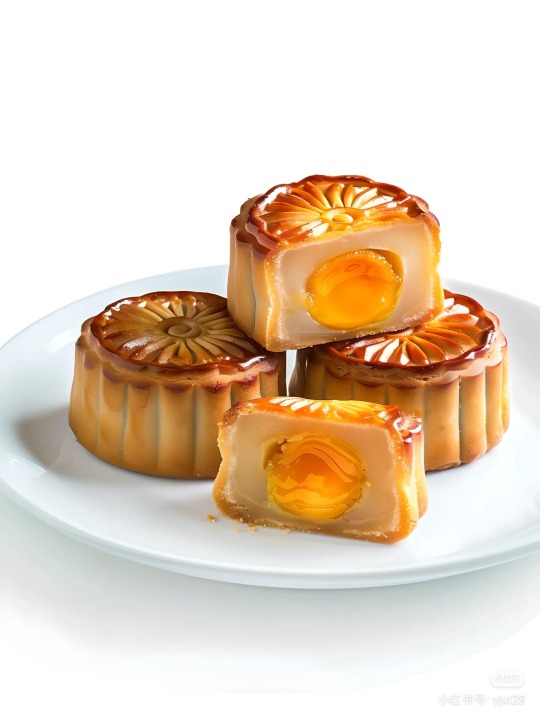
A mooncake (simplified Chinese: 月饼; traditional Chinese: 月餅) is a Chinese bakery product traditionally eaten during the Mid-Autumn Festival (中秋節).The festival is primarily about the harvest while a legend connects it to moon watching, and mooncakes are regarded as a delicacy. Mooncakes are offered between friends or on family gatherings while celebrating the festival. The Mid-Autumn Festival is widely regarded as one of the four most important Chinese festivals.
Mooncakes were originally used as offerings to worship the moon god.
Worshiping the moon is a very old custom in China. It is actually a worship activity for the "moon god" by the ancients. Eating mooncakes and appreciating the moon during the Mid-Autumn Festival are indispensable customs for celebrating the Mid-Autumn Festival in all parts of China. Mooncakes symbolize reunion. People regard them as festive food, use them to worship the moon, and give them to relatives and friends.
Cultural relics believed to be the predecessor of mooncakes were unearthed:
<China Tang Dynasty Baoxiang flower-patterned mooncakes/宝相花月饼>⬇️

Mooncakes, traditionally offered as a tribute to the Moon Goddess, have a long and rich history. The term "mooncake" was first recorded in the Southern Song Dynasty in Wu Zimu’s <梦梁录/Meng Liang Lu>.
Over time, mooncakes merged with various regional culinary traditions, giving rise to different styles such as Cantonese, Shanxi, Beijing, Suzhou, Chaozhou, and Yunnan mooncakes, all of which are beloved by people across China:
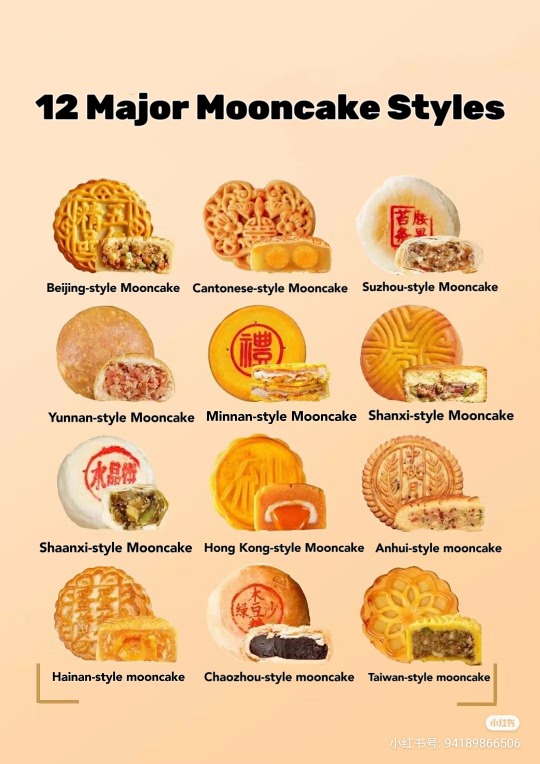
Mooncakes truly became associated with the Mid-Autumn Festival during the Ming Dynasty. In the writings of Liu Ruoyu 刘若愚, a eunuch during the reigns of the Wanli and Chongzhen emperors, he mentioned in his prison work Zhuozhong Zhi 《酌中志》(Vol. 20, "Brief Record of Culinary Preferences"): “八月宫中赏秋海棠、玉簪花。自初一日起,即有卖月饼者。加以西瓜、藕,互相馈送。西苑鹿藕。至十五日,家家供月饼瓜果,候月上焚香后,即大肆饮啖,多竟夜始散席者。如有剩月饼,仍整收于干燥风凉之处,至岁暮合家分用之,曰‘团圆饼’也”
Translation:
"In August, the palace having event appreciates autumn crabapple blossoms. From the first day of the month, mooncakes are sold,it accompanied by watermelons and lotus roots, and are exchanged as gifts.By the fifteenth day, every household offers mooncakes and fruits in worship, waiting for the moon to rise before burning incense and feasting lavishly, with some gatherings lasting all night. If there are leftover mooncakes, they are stored in a dry and cool place until the end of the year, when the whole family shares them, calling them 'reunion cakes.'
In the Qing Dynasty, there were books that detailed the methods of making mooncakes. For example, Zeng Yi, a female writer and female doctor in the late Qing Dynasty, recorded the "Method of Making Crisp Mooncakes" in her book "Zhongkuilu": "Use white ash flour, half of which is steamed in a steamer, and no water vapor is seen; the other half is raw, and kneaded with lard and cold water. Then, mix the steamed flour with lard. Use a ball of raw oil flour, and wrap a small ball of cooked oil flour inside; use a rolling pin to roll it into a cup-sized shape, fold it into a square; roll it into a ball again, and fold it into a square again; then wrap the filling. Use a cake stamp to stamp it, and put it on the stove to cook. For the oil-flavored filling, use cooked flour, sugar, walnuts, etc., and add a little sesame oil, so that it will not fall apart." The method is very similar to today's Suzhou-style mooncakes.
————————
🧚🏻Production & Model/Makeup:@曾嚼子
🔗Xiaohongshu:https://www.xiaohongshu.com/discovery/item/66e66ef70000000026033df2
————————
#chinese hanfu#hanfu#Mid-Autumn Festival#Zhong qiu jie#中秋节#mooncake#Chinese traditional food#Chinese Traditional Festivals#Chinese history#hanfu accessories#china#chinese
422 notes
·
View notes
Text

Shushu/tong ss24 at Shanghai fashion week
#shangai fashion week#moda#pretty dress#fashion#moda 2023#ss24#floral dress#shushu/tong#chinese fashion#asian fashion#female model#floral#alta moda#outfits
44 notes
·
View notes
Text
I'm watching a Chinese drama called Blossom right now and it's doing historical arranged marriage in such an interesting way and it's making me think more about my post about arranged marriage and particularly, what models of marriage has the female character seen growing up?
Because maybe part of why the Sad/Angry at arranged marriage princess/noble woman feels so hollow is because the mother is usually placidly sitting beside her husband pushing for marriage too. If your parents have a fine arranged marriage, what are you so worried about? It can come off more as a petulant kid than a real denunciation if we don't have indication that they really know what they're mad about or afraid of (Eloise Bridgerton...) Especially when they keep emphasizing how the girls are sheltered and ignorant, where did she manage to get this disillusioned?
This drama has so far shown three failed marriages, all unique. One marriage broke down because the husband was sexually assaulting female servants, another because after emotionally supporting her failure of a husband for 10 years, he took a second wife right after getting his dream job (that one felt so real), and the last woman accepted her marriage wouldn't have affection but was appalled when her husband cheated on her with her half-sister as it violated her sense of marital decency and respect.
What I really like the most is the characters mostly buy into, and all of them expect, marriage to be explicitly political. The whole mindset feels a lot more genuine to the time period. No one is Shocked Pikachu Face that they'll be asked to marry someone for family alliance reasons. And the anti-marriage female lead, she earned that opinion. She knows. She's haunted.
#not jane austen#arranged marriage#historical fiction#the female lead is heavily anti marriage but it's because SHE KNOWS#I feel like they try to have it both ways re girl's ignorance#She's SO sheltered she knows nothing about sex but she has opinions about marriage?#tw: sa mention#writing#a little more time building her character and why she dislikes this idea#instead of assuming she has reasons#maybe what I'm saying is walk us through the reasoning like P&P 2005#instead of assuming it's obvious#maybe Chinese dramas are just better at this i havent watched that many#blossom
212 notes
·
View notes
Text
April 13, Xi'an, China, Shaanxi Archaeology Museum/陕西考古博物馆 (Part 4 - Sui and Tang dynasties):
This is another star of the museum, a Tang dynasty (618 - 907 AD) bronze mirror, the back of which is decorated with carved luodian/螺钿 (mother of pearl). Near the edge are various birds, while the inner ring is arranged in a "sunflower" shape. Kinda wish I can see a modern replica of this one without all these marks and discolorations from the passage of time:

A Tang dynasty yupei/玉佩 (jade pendant). Unlike the Western Zhou dynasty yupei in part 2, this type is most definitely supposed to be hung from the waist. This one in particular was one of a set of two (both worn on waist, one on each side), and these were part of the formal wear of first to fifth rank officials during Tang dynasty:

Luo Wanshun's Epitaph/罗婉顺墓志. As mentioned in the first Beilin museum post, ancient Chinese epitaphs have a two-piece structure, consisting of a tablet and the protective covering on top. This is the protective covering on top, with the large inscription identifying this as the epitaph stone of Luo Wanshun, engraved in seal script/zhuanshu/篆书:

And here's the actual body of the epitaph. This particular epitaph was drafted by one of the "Eight Immortals of the Wine Cup"/饮中八仙, Li Jin/李琎 (he was also the nephew of Emperor Xuanzong of Tang/唐玄宗), and the calligraphy was provided by the famous calligrapher Yan Zhenqing/颜真卿:

Tang-era pottery figurines of the Chinese zodiac animals. This set is sadly incomplete, but the way these zodiac animals are partially anthropomorphized is pretty interesting. From left to right, these are tiger, rabbit, dragon, snake, sheep, and dog (yep that is a dog head, apparently). Not sure why rabbit and dog figurines are missing their ears though, maybe the ears broke off and are lost?

Sui dynasty (581 - 618 AD) green-glazed boshanlu/博山炉 incense burner. Note the panlong/蟠龙 dragon curled around the base:

Left: Sui dynasty white-glazed ewer with a chicken head-shaped handle. Right: Sui dynasty white-glazed vase. The curves on this one is *chef kiss*

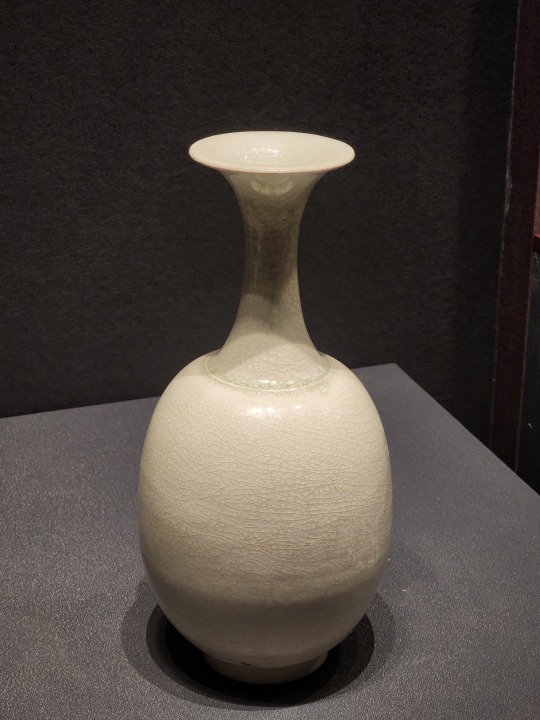
More Sui dynasty white glazed pottery, but the most incredible thing is the white porcelain cup in the middle. The lip of that cup is 1mm (~1/32 in) thick, and the sides are so thin, it's almost see through:

Tang-era sancai/三彩 glazed conjoined flasks that is shaped like a pair of fish. Similar twin-fish motif can be found in numerous traditional Chinese holiday decor, and symbolize auspiciousness, wealth, and surplus--especially surplus, since fish in Chinese (鱼) is pronounced yú, and "surplus" in Chinese (余) is also pronounced yú. This is why the phrase 年年有余 ("may there be a surplus every year") is often paired up with imagery of carps, children holding giant carps, or a twin-fish motif.
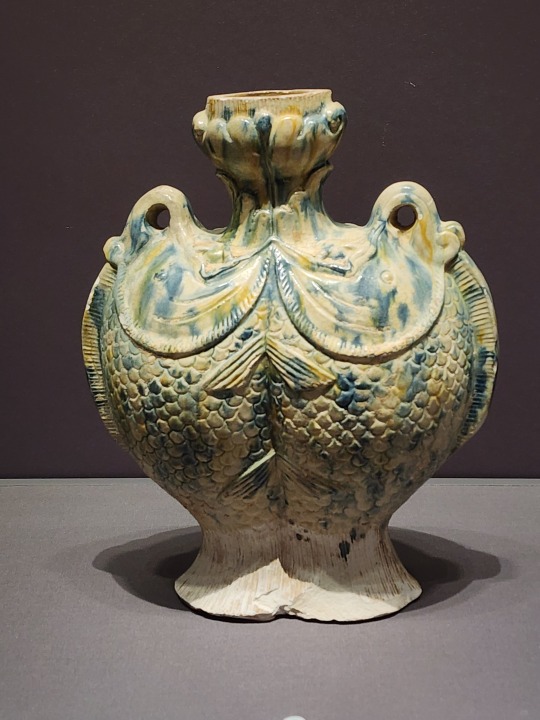
Absolutely beautiful Tang-era wall mural of a tiger, which was very sadly damaged over time. But from the pieces left, you can still appreciate the raw power of the tiger captured by these lines:

Another beautiful Tang-era wall mural depicting men on horseback playing "polo", called maqiu/马球 (lit. "horse ball") in Chinese. It's unclear whether the maqiu depicted here originated in China in late Eastern Han dynasty (25 - 220 AD) or was brought to China via the Silk Road at the beginning of Tang dynasty, but anyway this sport was very popular during Tang dynasty, and there were many female players at the time too.
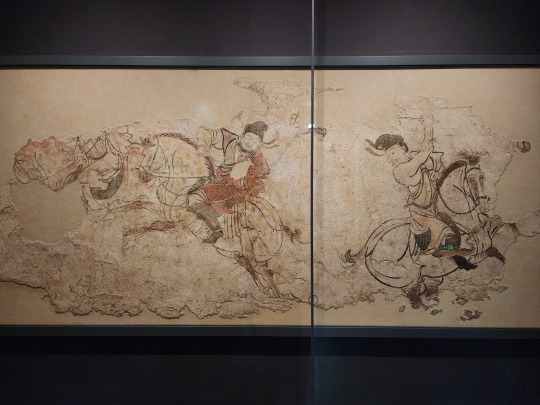
The women of Tang dynasty as depicted by pottery figurines:


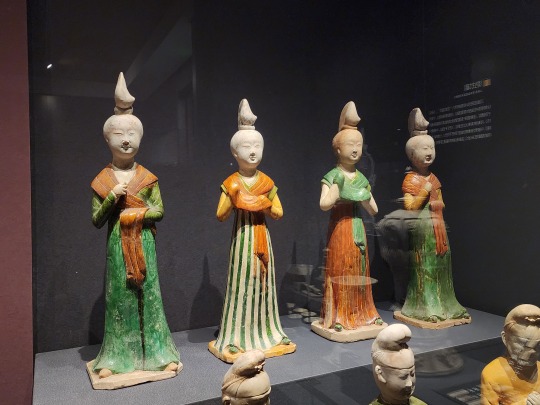

A small model of Tang-era triple que/阙 gate towers. Que gate towers first appeared in Western Zhou dynasty (1046 - 771 BC) and have been a part of Chinese architecture ever since. Que gate towers usually come in pairs, one on each side of the gate, and they were used to display status.

A map of Tang dynasty Chang'an city laid on top of the current map of Xi'an city, showing the imperial palace (top center), the East Market/东市 and West Market/西市, and the 108 districts (called fang/坊):

A Tang-era chiwen/鸱吻 (螭吻 is the original name, 鸱吻 is the alternative name, another alternative name is 蚩吻, but the pronunciation remains the same for all three) roof ornament. These are the pairs of horn-shaped pieces on the top of the roof of traditional Chinese architecture. These ornaments are made to represent the Ninth Son of the Dragon, called Chiwen/螭吻, which looks like a dragon-headed fish and has the power to control water, thus it's used in traditional Chinese architecture to ward off fires:
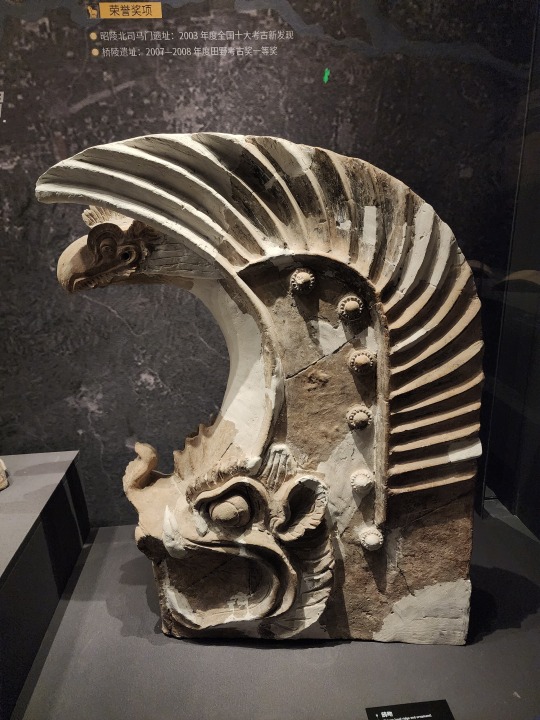
Sui-era gold gilded handle of a stone sarcophagus:

A pottery jar found buried in the tomb of Crown Prince Jiemin/节愍太子 (Li Chongjun/李重俊, son of Emperor Zhongzong of Tang/唐中宗 Li Xian/李显), partially shaped like a pagoda and decorated with various Buddhist motifs such as lotus petals and elephant heads. This is speculated to be a representation of a granary, which would hold grains for the crown prince in the afterlife:
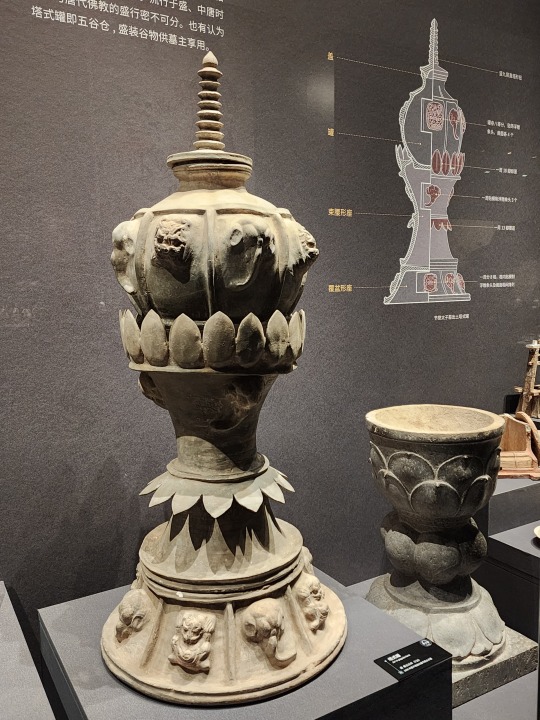
And last but not least, a Sui-era pottery camel bearing sacks that have the imagery of the Greek god of wine Dionysus upon them, which shows the great amount of cultural exchange that took place back then:

#2024 china#xi'an#china#shaanxi archaeology museum#chinese history#chinese culture#sui dynasty#tang dynasty#chinese calligraphy#calligraphy#archaeology#history#culture
246 notes
·
View notes



